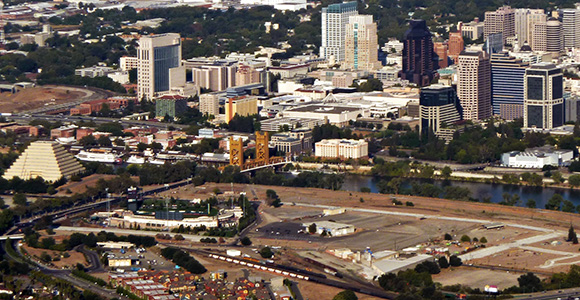
The city of West Sacramento (bottom) is considering using an EIFD to fund building two bridges across the river to Sacramento. (Photo Credit: Basil D Soufi/Flickr)
After years of the vacuum left by the end of California’s redevelopment agencies, the California Economic Summit two years ago helped craft a robust new financing tool for local governments looking to pay for local infrastructure and economic development.
Now there are an estimated 60 projects under consideration across California using the “Enhanced Infrastructure Financing District” as a way of funding projects. And that number is expected to increase.
Following the dissolution of redevelopment agencies in 2011, local governments struggled to pay for everything from long-neglected sidewalks and roads to the mass-transit and affordable housing needed for long-term sustainable growth.
“People see EIFDs as a way to spur local and regional investment,” said Fred Silva, senior fiscal analyst for California Forward, which is beginning to provide EIFD technical assistance where requested. “We encourage local leaders to develop a business plan for economic development of their communities and determine the infrastructure investments that will be needed to sustain a healthy local economy over time.”
Last week in Los Angeles, a forum hosted by the Southwest Megaregion Alliance, a Knowledge Partner of the California Economic Summit, attracted more than 50 people, including city and regional leaders and consultants who are already working on projects and looking into using EIFDs to fund them.
“It was a sort of EIFD 2.0,” said Mark Pisano, who noted that there are up to 60 EIFD projects in some sort of development across California.
Pisano is the former executive director of the Southern California Association of Governments, the nation’s largest metropolitan planning organization. He is also co-lead of the Summit’s Infrastructure Action Team and has been promoting EIFDS as a flexible structure that give local entities a vehicle to fund economic development.
While there was some initial confusion about EIFDs and how they worked, it appears that there is a better understanding of how the EIFDs can help economic development.
“People more than understand it,” Pisano said. “They are beginning to do it.”
Long-time California urban economics and financial consultant Stan Hoffman attended the meeting.
“The EIFD can be an important tool that cities should evaluate,” Hoffman said. ”It’s not the whole toolbox, but it can be valuable.”
Some of the projects that are maturing include one in the city of West Sacramento, which wants to use an EIFD to help finance two new bridges across the Sacramento River to the city of Sacramento on the other side. The city of La Verne is looking at an EIFD for a transit-oriented development plan around the Gold Line, and the city of Los Angeles is considering using EIFDs in plans to revitalize the area around the L.A. River.
There are still many other civic and business leaders who are in the early stages of learning more about EIFDs. On Friday in Palm Desert, Assemblymember Eduardo Garcia brought together Coachella Valley civic and business leaders interested in learning more about EIFDs. Silva and Pisano were among a handful of experts who were explaining how to define and set one up.
“Enhanced Infrastructure Financing Districts and Community Revitalization Authorities are valuable tools that provide cities and special districts with financing mechanisms to invest in infrastructure and affordable housing,” said Garcia, who is chairman of the Assembly Committee on Jobs, Economic Development and the Economy.
The discussion at Friday’s session centered on four key questions in getting an EIFD created and underway.
- What financing instruments could work?
- Who else needs to be a part of this process?
- What can be done to help broker ideas and projects?
- What needs to happen next?
“Through my involvement in the California Economic Summit, it is important to me that we hold workshops to help local governments understand and better utilize these tools,” Garcia added. “Increasing investment in our local communities will help address poverty, high unemployment, and the shortage of housing that’s affordable, thereby helping to create strong and resilient local economies and communities.”

